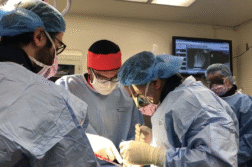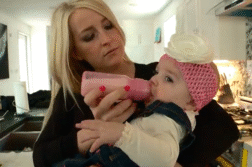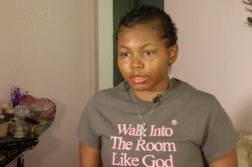NEW YORK, N.Y. (Ivanhoe Newswire) — One in eight women in the United States will develop breast cancer in her lifetime. Breast cancer most frequently develops in women aged 65 to 74, but five percent of breast cancer cases develop in women in their thirties, twenties and even late teens. Ivanhoe shows us there are some unique challenges for these young women.
Roshni Kamta graduated from Rutgers University and had started a new life in New York City when she discovered a lump in her breast. At first, she shrugged it off.
“I didn’t think anything of it because of my age.” Roshni said. She was just 22. But then … “A couple more weeks went by, towards the end of April, and I found blood in my bra.” Commented Roshni.
Roshni says she had a tough time finding a doctor who would see her quickly, since breast cancer is rare in a woman her age, but she was persistent.
Roshni stated, “I knew what was going on in my body.”
After a mammogram, a needle biopsy confirmed Roshni’s suspicions. She found breast cancer specialist Hanna Irie.
Hanna Irie, MD, PhD, Breast Oncologist, at Dubin Breast Center Mount Sinai said, “She’s definitely one of the youngest. The youngest patient I have treated was 19 years old.”
Doctor Irie says it’s important that young women not ignore changes in the shape or contour of their breasts or unusual discharge. There are also other considerations for young patients.
Roshni commented, “My doctor didn’t want me to have any complications with my life beyond, you know, the months of treatments.”
Roshni made the decision to harvest and freeze her eggs so she could have a family in the future.
Roshni says she was not prepared mentally or emotionally. Chemo would dramatically change her looks.
Roshni told Ivanhoe, “I’ve always had hair, I’m Indian. You know, it’s known for us to, like, care for our hair and our hair becomes our identity, basically.”
She changed her locks in stages. A salon in New York cut her hair to her shoulders, then to her chin, and finally, shaved her head.
“I’ve always wanted purple hair. Purple is my favorite color.” Roshni explained. Then, she purchased a collection of wigs so she could change her looks to suit her mood.
Now 26, Roshni’s hair has grown back, and after surgery and 33 rounds of radiation, her cancer is in remission.
Doctor Irie says, “Her prognosis is excellent.”
And she’s on a mission to remind other young women to pay attention to their health.
Roshni suggest, “Check your body and, you know, do your self-breast exams. And if there’s something wrong, tell your doctor.”
Doctor Irie says Roshni had triple negative breast cancer, which is often more common in younger women. One of the lessons Roshni learned during her cancer journey is that insurance would not pick up the cost of egg harvesting, so she found a non-profit organization, The Chick Mission, that covered the cost: www-dot-thechickmission.org.
Contributors to this news report include: Cyndy McGrath, Producer; Roque Correa, Editor and Kirk Manson, Videographer
Sources:
https://www.cancer.org/cancer/breast-cancer/about/how-common-is-breast-cancer.html
https://www.healthline.com/health/breast-cancer/breast-cancer-20s-30s
https://www.thechickmission.org/
NEVER TOO YOUNG: BREAST CANCER IN YOUR 20’S
REPORT #2975
BACKGROUND: After skin cancer, breast cancer is the most common cancer diagnosed in women in the United States. Breast cancer can occur in both men and women, but it’s far more common in women. Signs and symptoms of breast cancer may include a breast lump or thickening that feels different from the surrounding tissue, change in the size, shape or appearance of a breast, changes to the skin over the breast, such as dimpling, a newly inverted nipple, peeling, scaling, crusting or flaking of the pigmented area of skin surrounding the nipple (areola) or breast skin, redness or pitting of the skin over your breast, like the skin of an orange. Doctors know that breast cancer occurs when some breast cells begin to grow abnormally. These cells divide more rapidly than healthy cells do and continue to accumulate, forming a lump or mass. Cells may spread (metastasize) through your breast to your lymph nodes or to other parts of your body. Breast cancer most often begins with cells in the milk-producing ducts (invasive ductal carcinoma). Breast cancer may also begin in the glandular tissue called lobules (invasive lobular carcinoma) or in other cells or tissue within the breast.
(Source: https://www.mayoclinic.org/diseases-conditions/breast-cancer/symptoms-causes/syc-20352470)
THE STUDY: To diagnose if someone has breast cancer a doctor will perform tests and procedures used to diagnose breast cancer including a breast exam where your doctor will check both of your breasts and lymph nodes in your armpit, feeling for any lumps or other abnormalities. A mammogram is an X-ray of the breast. If an abnormality is detected on a screening mammogram, your doctor may recommend a diagnostic mammogram to further evaluate that abnormality. An ultrasound that may be used to determine whether a new breast lump is a solid mass or a fluid-filled cyst. Or they could remove a sample of breast cells for testing. They will send the sample to a biopsy lab for analysis where experts determine whether the cells are cancerous. A biopsy sample is also analyzed to determine the type of cells involved in the breast cancer, the aggressiveness of the cancer, and whether the cancer cells have hormone receptors or other receptors that may influence your treatment options. An MRI is also used when diagnosing breast cancer.
(Source: https://www.mayoclinic.org/diseases-conditions/breast-cancer/diagnosis-treatment/drc-20352475)
NEW REGULATIONS: Breast cancer in young women is relatively rare compared to breast cancer occurring in older women. Younger women diagnosed with breast cancer also tend to have a more aggressive biology and consequently a poorer prognosis than older women. In addition, they face unique challenges such as diminished fertility from premature ovarian failure, extended survivorship periods and its attendant problems, and the psychosocial impact of diagnosis, while still raising families. Young women with breast cancer have similar surgical options as older women. These include breast conservation therapy or mastectomy. Although young age at diagnosis is associated with a higher risk of local recurrence and more aggressive phenotypes, data suggest no survival gains with mastectomy compared to breast conservation therapy, and there does not appear to be a survival advantage with contralateral prophylactic mastectomy either. Therefore, young age alone is not a contraindication to breast conservation therapy. Despite this, bilateral mastectomies are on the rise in women of all ages. This is likely due to patient and physician perception of improved outcomes and due to improved reconstruction techniques and cosmesis. Immediate and immediate-delayed reconstruction are now preferred, and many women are candidates for nipple sparing procedures with immediate or immediate-delayed reconstruction. Nipple sparing procedures are increasingly being offered as data supports the oncologic safety, and these procedures are associated with better self-image.
(Source: https://www.ncbi.nlm.nih.gov/pmc/articles/PMC4694614/)
* For More Information, Contact: Lindsey Diaz-Macinnis
Lindsey.diaz-macinnis@mountsinai.org
Free weekly e-mail on Medical Breakthroughs from Ivanhoe. To sign up: http://www.ivanhoe.com/ftk



